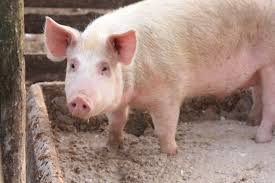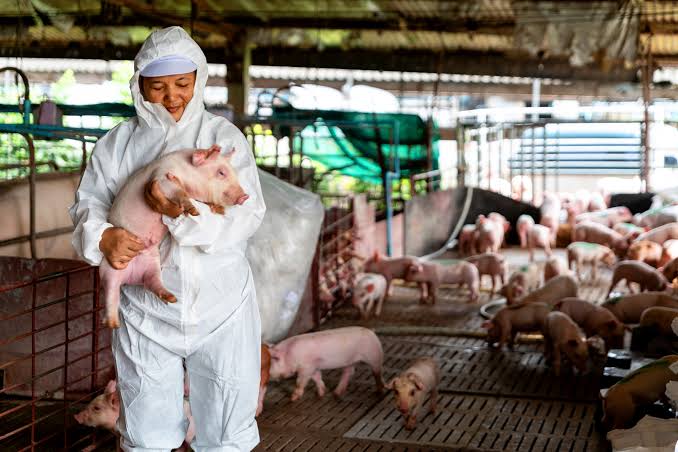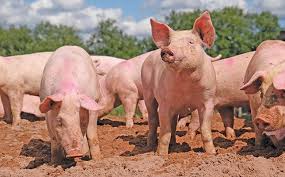Hog cholera, also known as classical swine fever, is a contagious viral disease affecting pigs. Its scientific name is Pestivirus C, and it belongs to the Flaviviridae family. This illness poses a significant threat to the global swine population, impacting both domestic and wild pigs.
The virus responsible for hog cholera primarily targets pigs, causing a wide range of symptoms. Affected animals may exhibit fever, lethargy, and a decrease in appetite. Additionally, they may experience respiratory distress and show signs of gastrointestinal upset. The virus spreads easily among pigs through direct contact, contaminated feed, or even via insects that can carry the virus from one pig to another.
One distinctive feature of hog cholera is its ability to cause acute or chronic forms of the disease. In the acute form, infected pigs may succumb rapidly to severe symptoms, leading to high mortality rates within affected herds. On the other hand, the chronic form results in a prolonged illness with persistent symptoms, impacting the overall health and productivity of the pig.
Preventing the spread of hog cholera is crucial in maintaining the health of pig populations. Strict biosecurity measures, such as controlling pig movements, proper disposal of infected carcasses, and maintaining hygiene in pig farms, play a pivotal role in disease prevention. Vaccination is also an essential tool in managing hog cholera, helping to build immunity in pigs and reduce the severity of the disease.
Global efforts have been underway to control and eradicate hog cholera. These initiatives involve collaboration between veterinary authorities, farmers, and researchers to implement effective disease surveillance, control measures, and vaccination programs. The goal is to minimize the economic impact of hog cholera on the swine industry and protect the livelihoods of farmers who rely on pig farming for their income.
Additionally, hog cholera, scientifically known as classical swine fever, is a viral disease with significant implications for pig populations worldwide. Its ability to spread rapidly and cause severe symptoms makes it a challenging concern for the swine industry. Through rigorous biosecurity measures, vaccination, and global cooperation, efforts are being made to control and eradicate this disease, ensuring the well-being of pig populations and safeguarding the livelihoods of those involved in the swine industry.
Read Also: Different Systems of Snail Production
Animals Affected by Hog Cholera (Pestivirus C)

Hog cholera, or classical swine fever, primarily affects pigs, both domesticated and wild. The virus is highly contagious among swine, and various species within the pig family can be susceptible to its impact. In addition to domestic pigs, feral pigs and wild boars are also vulnerable to hog cholera.
Within the domestic pig population, hog cholera can affect pigs of all ages, from piglets to adults. The severity of the disease can vary, leading to acute or chronic forms with differing clinical manifestations. The virus can spread rapidly within pig herds, especially in situations where there is close contact among animals.
Feral pigs and wild boars are also at risk of contracting hog cholera. The virus can have significant ecological implications when it infects wild swine populations, potentially leading to increased mortality and impacting the balance of ecosystems.
The susceptibility of different species within the swine family underscores the importance of comprehensive disease management strategies. Efforts to control and prevent hog cholera must consider the broader context, including both domestic and wild pig populations, to effectively mitigate the spread of the virus and minimize its impact on animal health and the swine industry.
Damages Caused by Hog Cholera
Hog cholera, also known as classical swine fever, inflicts substantial damages on the swine industry due to its contagious nature and severe impact on pig health. The damages caused by hog cholera are diverse and affect various aspects of pig farming and related industries.
1. Economic Losses: One of the most significant damages is the economic impact on the swine industry. Outbreaks of hog cholera can lead to substantial financial losses for pig farmers. The disease can result in high mortality rates, reduced growth rates, and decreased reproductive performance, all of which contribute to economic setbacks.
2. Trade Restrictions: Countries or regions experiencing hog cholera outbreaks often face trade restrictions. Many nations impose bans on the importation of pigs or pork products from areas affected by the disease to prevent its spread. This hampers international trade and can have long-lasting consequences on the affected region’s economy.
3. Decreased Productivity: Infected pigs may experience a decline in productivity. This includes reduced feed efficiency, slower weight gain, and lower reproductive success. These factors contribute to decreased overall output in pig farming operations, affecting the efficiency of meat production.
4. Animal Welfare Concerns: Hog cholera can cause significant suffering for affected pigs. The disease can lead to severe clinical signs, including high fever, respiratory distress, and gastrointestinal issues. Infected pigs may experience pain and discomfort, raising ethical concerns about animal welfare.
5. Increased Mortality Rates: In severe outbreaks, hog cholera can lead to high mortality rates within affected pig herds. This not only results in the loss of individual animals but also disrupts the stability of pig farming operations and can lead to long-term consequences for the industry.
6. Costs of Disease Control Measures: Implementing measures to control and contain hog cholera outbreaks involves considerable costs. Expenses related to vaccination, quarantine procedures, and biosecurity measures contribute to the financial burden on pig farmers and veterinary authorities.
7. Environmental Impact: The disease can also have an environmental impact when it affects feral pigs and wild boars. Increased mortality rates in wild swine populations can disrupt ecosystems and alter the dynamics of wildlife in certain regions.
The damages caused by hog cholera extend beyond the immediate health implications for pigs. The economic, trade-related, and societal consequences make effective disease management crucial to safeguarding the well-being of pig populations and the sustainability of the swine industry.
Read Also: Snail Farming Step-by-Step Beginners Guide
Control and Preventive Measures

Controlling and preventing hog cholera, or classical swine fever, involves a comprehensive approach that addresses various aspects of pig farming and biosecurity. Here are key measures taken to manage and mitigate the impact of hog cholera:
1. Vaccination Programs: Implementing vaccination programs is a crucial preventive measure. Vaccines are designed to stimulate the pig’s immune system, providing protection against the virus. Routine vaccination helps build immunity within pig populations and reduce the severity of the disease.
2. Biosecurity Practices: Strict biosecurity measures are essential to prevent the introduction and spread of hog cholera. This includes controlling access to pig facilities, maintaining proper hygiene, and implementing measures to prevent contact between infected and healthy pigs. Biosecurity protocols are critical in both commercial and backyard pig farming settings.
3. Surveillance and Early Detection: Regular surveillance for signs of hog cholera is vital for early detection of the virus. Prompt identification of infected animals allows for quick response measures, such as quarantine and disease control, to limit the spread of the disease within pig herds.
4. Quarantine Procedures: Infected pigs and those suspected of being exposed to the virus should be isolated and placed under quarantine. This helps prevent the spread of the disease to healthy animals. Quarantine measures are part of a broader strategy to control outbreaks and protect unaffected pig populations.
5. Movement Controls: Implementing restrictions on the movement of pigs helps prevent the spread of hog cholera between farms. Controlling the transportation of live pigs and pig products reduces the risk of introducing the virus to new areas.
6. Proper Disposal of Infected Carcasses: Safe and timely disposal of carcasses from infected pigs is crucial to prevent further contamination. Adequate disposal methods, such as burial or incineration, are employed to minimize the risk of the virus persisting in the environment.
7. Public Awareness and Education: Informing pig farmers, veterinarians, and the public about hog cholera is essential. Educational programs raise awareness about the disease, its transmission, and the importance of implementing preventive measures. This helps create a collaborative effort to control and eradicate the virus.
8. International Collaboration: Given the global nature of the swine industry, international collaboration is vital. Sharing information, expertise, and resources helps coordinate efforts to control and prevent hog cholera on a broader scale. Cooperation between countries is crucial to managing trade-related aspects and preventing the transboundary spread of the virus.
By combining these measures, a holistic approach to disease control and prevention can be achieved. This multifaceted strategy aims to protect pig populations, ensure the sustainability of the swine industry, and minimize the economic and societal impact of hog cholera.
Frequently Asked Questions (FAQs) About Hog Cholera (Pestivirus C)
Q1: What is hog cholera?
A: Hog cholera, also known as classical swine fever, is a highly contagious viral disease that primarily affects pigs, both domesticated and wild.
Q2: What is the scientific name for hog cholera?
A: The scientific name for hog cholera is Pestivirus C, and it belongs to the Flaviviridae family.
Q3: How is hog cholera transmitted?
A: The virus can spread through direct contact between infected and healthy pigs, contaminated feed, and even through insects that carry the virus.
Q4: What are the symptoms of hog cholera in pigs?
A: Symptoms include fever, lethargy, decreased appetite, respiratory distress, and gastrointestinal issues. The disease can manifest as acute or chronic forms.
Q5: Can other animals get infected with hog cholera?
A: Hog cholera primarily affects pigs, including domesticated pigs, feral pigs, and wild boars. Other animal species are generally not susceptible.
Q6: How is hog cholera diagnosed?
A: Diagnosis involves laboratory tests on blood or tissue samples from infected pigs. Serological tests and polymerase chain reaction (PCR) assays are commonly used.
Q7: What measures can be taken to prevent hog cholera outbreaks?
A: Prevention includes vaccination programs, strict biosecurity practices, surveillance for early detection, quarantine of infected animals, and movement controls.
Q8: What are the economic impacts of hog cholera?
A: The disease can lead to economic losses in the swine industry due to high mortality rates, decreased productivity, trade restrictions, and increased costs for disease control measures.
Q9: Can humans get infected with hog cholera?
A: No, hog cholera does not pose a direct threat to human health. The virus is specific to pigs and does not infect humans.
Q10: Is there a cure for hog cholera?
A: Currently, there is no specific cure for hog cholera. Prevention through vaccination and strict biosecurity measures is key to managing the disease.
Q11: How is hog cholera controlled on a global scale?
A: Global efforts involve international collaboration, information sharing, vaccination programs, and strict control measures to manage and eradicate the disease on a broader scale.
Read Also: Low-Maintenance Plants for Beginners

